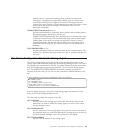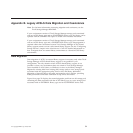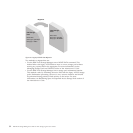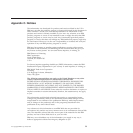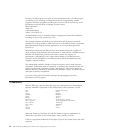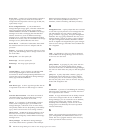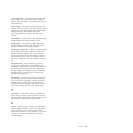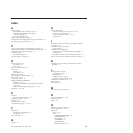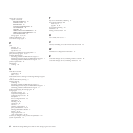device class. A named set of characteristics applied to
a group of storage devices. Each device class has a
unique name and represents a device type of disk, file,
optical disk, or tape.
device configuration file. (1) On an IBM Tivoli
Storage Manager storage agent, a file that contains the
name and password of the storage agent, and the
DEFINE SERVER command for the IBM Tivoli Storage
Manager server that is managing the SAN-attached
libraries and drives. (2) On an IBM Tivoli Storage
Manager server, a file that contains information about
defined device classes, and, on some IBM Tivoli Storage
Manager servers, defined libraries and drives.
device driver. A collection of subroutines that control
the interface between I/O device adapters and the
processor.
domain. A grouping of client nodes with one or more
policy sets, which manage data or storage resources for
the client nodes.
dsm.opt file. See client options file.
dsmserv.opt. See server options file.
dsmsta.opt. See storage agent options file.
E
external library. A type of library provided by IBM
Tivoli Storage Manager to allow LAN-free data
movement for ACSLS-managed StorageTek libraries. To
activate this support, the IBM Tivoli Storage Manager
library type must be EXTERNAL.
F
FILE device type. A device type that specifies the use
of sequential access files on disk storage as volumes.
L
LAN-free data movement. The direct movement of
client data between a client machine and a storage
device on a SAN, rather than on the LAN.
library. (1) A repository for demountable recorded
media, such as magnetic tapes. (2) For IBM Tivoli
Storage Manager, a collection of one or more drives,
and possibly robotic devices (depending on the library
type), which can be used to access storage volumes.
library client. An IBM Tivoli Storage Manager server
that uses server-to-server communication access to a
library that is managed by another IBM Tivoli Storage
Manager server.
library manager. An IBM Tivoli Storage Manager
server that controls device operations when multiple
IBM Tivoli Storage Manager servers share a storage
device. The device operations include mount,
dismount, volume ownership, and library inventory.
M
management class. A policy object that users can bind
to each file to specify how the server manages the file.
The management class can contain a backup copy
group, an archive copy group, and space management
attributes. The copy groups determine how the server
manages backup versions or archive copies of the file.
The space management attributes determine whether
the file is eligible to be migrated by the space manager
client to server storage, and under what conditions the
file is migrated.
N
node. A workstation or file server that is registered
with an IBM Tivoli Storage Manager server to receive
its services. See client node.
P
policy domain. A grouping of policy users with one
or more policy sets, which manage data or storage
resources for the users. In IBM Tivoli Storage Manager,
the users are client nodes. See policy set and management
class.
policy set. A policy object that contains a group of
management classes that exist for a policy domain.
Several policy sets can exist within a policy domain,
but only one policy set is active at one time. See policy
domain and management class.
R
reclamation. A process of consolidating the remaining
data from many sequential access volumes onto fewer
new sequential access volumes.
restore. To copy information from its backup location
to the active storage location for use. In IBM Tivoli
Storage Manager, you can restore the server database,
storage pools, storage pool volumes, and users’
backed-up files. The backup version of a file in the
storage pool is not affected by the restore operation.
Contrast with backup.
S
server. The program that provides backup, archive,
space management, and administrative services to
clients. The server program must be at the necessary
level to provide all of these services.
58 IBM Tivoli Storage Manager for SAN for AIX: Storage Agent User’s Guide



